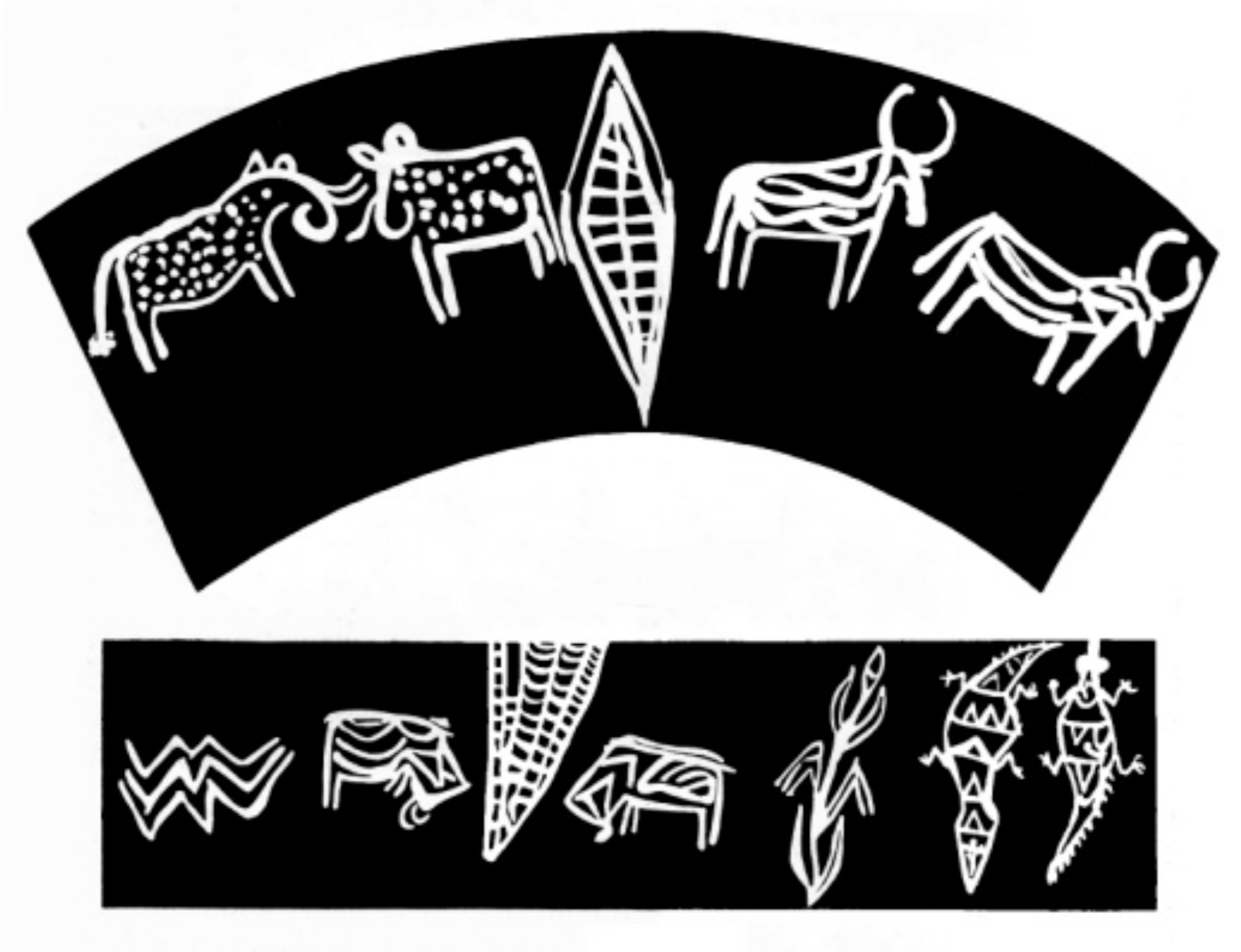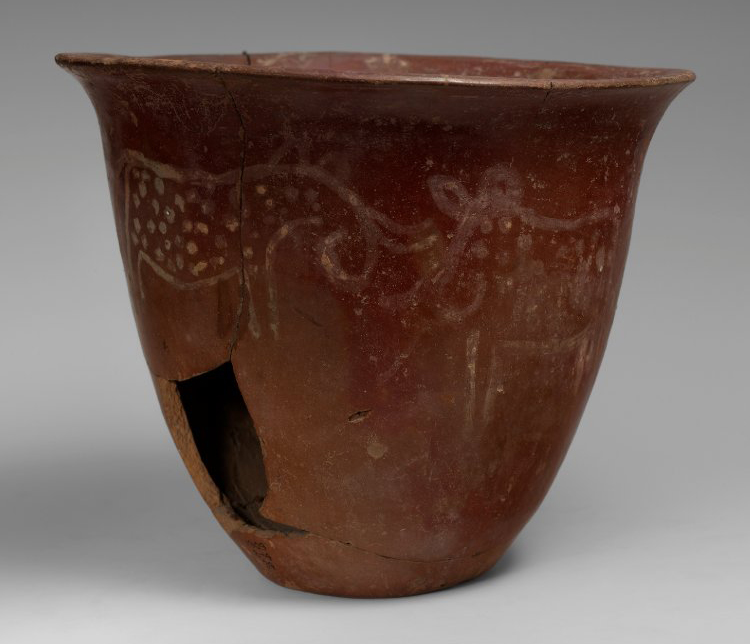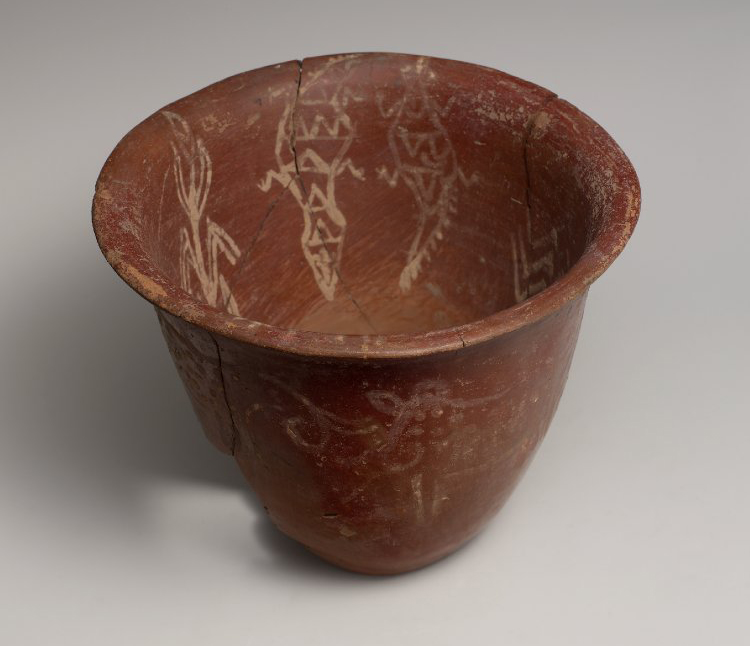C-Ware – squat beaker C-0170
By Droux, Xavier
, Tomb H97.
1909 : Egypt Exploration Fund excavation.London, British Museum, EA 49025.
Date : Naqada IA–IIB
General range of C-ware production
Material : Nile silt (Painted)
Preservation : Almost complete
Decoration preservation : Partially faded
Preservation information :
Repaired from several sherds, one of which is missing in the lower part of the beaker. No decoration was present on that missing sherd.
Decoration
The inside of the vessel shows two hippopotami, facing each other and separated by a crosshatched triangle. Their ears and incisors are shown. Their bodies are filled with chevrons and lines. On the opposite side, two crocodiles are represented vertically in top view, head to tail. Their legs are flexed and end with toed claws. Small dots on the tails indicate the scales of the hide. Their bodies are filled with lines and triangles. Inbetween these two pairs of animals are a plant motif on one side and a group of three horizontal wavy lines on the other side.
On the outside, two elephants face each other. Their trunks are curled and their tusks clearly indicated, as well as their long tails ending in a tassel of hair. It is striking that the massive ears of the elephants are not strongly indicated: they appear only as two relatively small rounded outlines on top of the heads. Their bodies are filled with dots. Separated from the elephants by a diamond-shaped element are two right-facing bulls with long crescent-shaped horns. Their bodies are filled with undulating lines and their tail is indicated.
Dimensions (cm)
18.5
20.3
20.3
Base diameter: 7.7
Additional information
Open
Vi 110
Oi 100
flat base
Inside and outside
Comments
Missing sherd is not painted.
References
1911
Pre-dynastic cemetery at El Mahasna. Egypt Exploration Fund 31. London
, 12-13, 28, pl. XIV, 1-4.1921
Corpus of prehistoric pottery and palettes. British School of Archaeology in Egypt & Egyptian Research Account 32, 23rd year, 1917. London
, pl. LXI, 52T.1928
Some prehistoric vases in the British Museum and remarks on Egyptian prehistory. Journal of Egyptian Archaeology 14
, 268-9, fig. 5, pl. XXVII, 5.1952
Manuel d'archéologie égyptienne I: 1; les époques de formation, la préhistoire. Paris
, 274, fig. 175.1989
Das Nilpferd in der Vorstellungswelt der alten Ägypter. Teil I, Katalog. Europäische Hochschulschriften VIII, 22. Frankfurt am Main
, doc. 24d.1998
Peaux d'animaux comme symboles prédynastiques: à propos de quelques représentations sur les vases White Cross-lined. Chronique d'Egypte 73
, 209, n. 12; 210, n. 14.2004
Elephants at Hierakonpolis, in: Hendrickx, Stan; Friedman, Renée; Ciałowicz, Krzysztof M.; Chłodnicki, Marek (eds), Egypt at its origins: studies in memory of Barbara Adams; proceedings of the International Conference "Origin of the State. Predynastic and Early Dynastic Egypt", Kraków, 28th August–1st September 2002. Orientalia Lovaniensia Analecta 138. Leuven
, 151-3, fig. 14.2009
Les peintures sur vases de Nagada I–Nagada II: nouvelle approche sémiologique de l'iconographie prédynastique. Egyptian Prehistory Monographs 6. Leuven
, cat. 103.2015
Riverine and desert animals in predynastic Upper Egypt: material culture and faunal remains. Dphil thesis, University of Oxford. Oxford
, cat. 1.46.2019
Le taureau à l’époque prédynastique et son importance pour le développement de l’iconographie royale – avec un excursus sur l’origine du sceptre héqa, in: Aufrère, Sydney (ed.), Les taureaux de l’Égypte ancienne. Publication éditée à l’occasion de la 14e Rencontre d’égyptologie de Nîmes. Égyptonimes 2
, 38.






